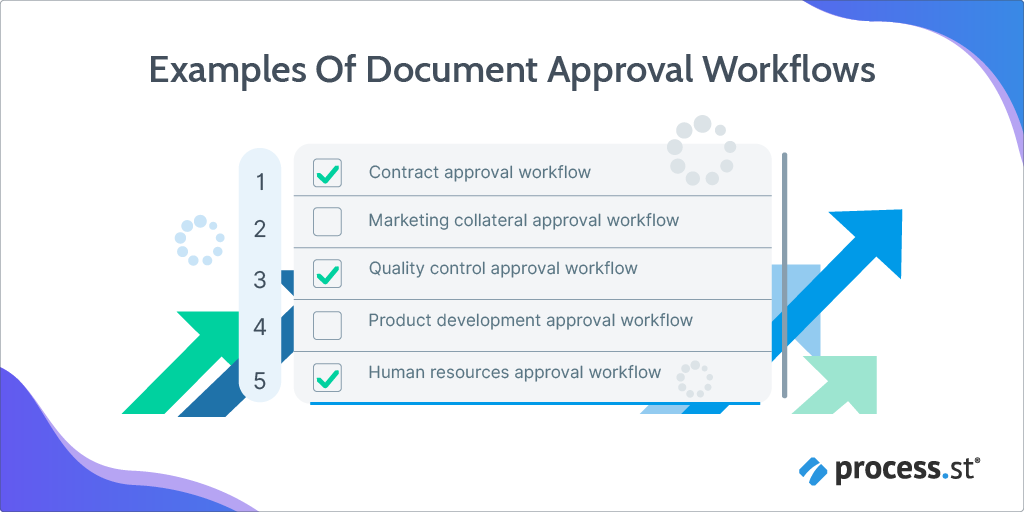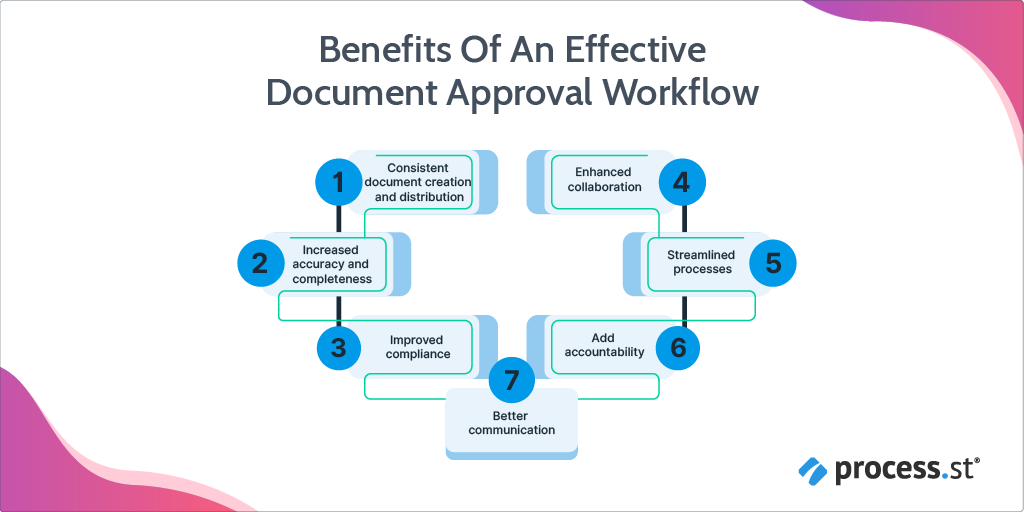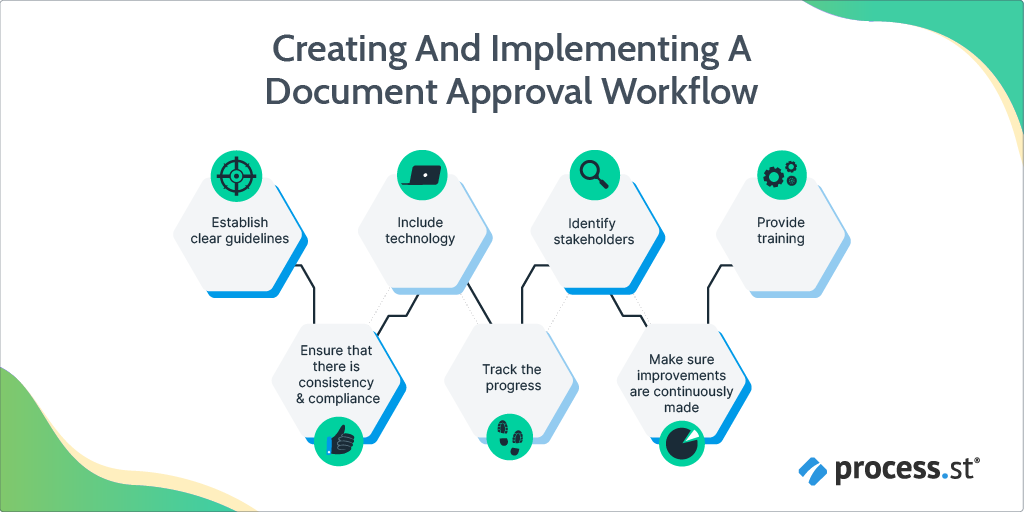Get started quickly, see results immediately, no code needed.
The Document Approval Workflow for Reduced Bottlenecks
Document approval workflows are essential for organizations of all sizes and types. Whether you work in a large corporation or a small business, it’s critical to have a process that ensures all documents are reviewed and approved before they are shared or published.
Without that, you’re bottlenecked and left searching for documents in different email threads, folders, and Slack messages. Valuable time and resources are lost. So, how can you go about creating and implementing an effective document approval workflow? We’ve got everything you need to know.
What is a document approval workflow?
A document approval workflow is a defined process that outlines the steps necessary for a document to be reviewed, edited, and approved by authorized individuals or departments within an organization. The workflow ensures that the document goes through a series of checks and balances to ensure accuracy, completeness, and compliance with established guidelines or regulations.
Examples of document approval workflows
Here are some examples of document approval workflows that organizations may use:
Contract approval workflow
A contract approval workflow involves multiple stakeholders, including legal, finance, and management, who must review and approve a contract before it can be executed. It typically includes steps such as:
- Initial drafting
- Legal review
- Negotiation
- Final approval.
Marketing collateral approval workflow
This workflow details the creation and approval of marketing materials, such as brochures, flyers, and social media posts. The workflow generally involves steps such as:
- Initial drafting
- Review by subject matter experts
- Legal and compliance review
- Final approval by marketing management
Product development approval workflow
Your product development approval workflow covers the approval of new products or updates to existing products. This workflow typically encompasses tasks such as
- Initial concept review
- Design and development
- Review by subject matter experts and stakeholders
- Legal and compliance review
- Final approval by product management
Quality control approval workflow
This workflow involves the review and approval of quality control procedures and documentation, such as standard operating procedures, work instructions, and quality control plans. The workflow likely includes steps such as:
- Initial drafting
- Review by subject matter experts
- Legal and compliance review
- Final approval by quality control management
Human resources approval workflow
The human resources approval workflow involves the creation and approval of HR policies, procedures, and employee documents. This could include:
- Job descriptions
- Employee handbooks
- Performance evaluations
You’re likely to see these tasks in your workflow:
- Initial drafting
- Review is done by subject matter experts and stakeholders
- Legal and compliance review
- Final approval by HR management
The importance of a document approval workflow
A document approval workflow is important for several reasons:
Ensuring accuracy and completeness
A document approval workflow ensures that documents are thoroughly reviewed and edited by multiple individuals before they are approved and distributed. This helps to minimize errors and make sure that documents are accurate and complete.
Ensuring compliance
Many organizations are subject to regulations and guidelines that govern how they handle and distribute documents. A document approval workflow helps ensure that documents are compliant with these regulations and guidelines.
Maintaining consistency
A document approval workflow can help ensure that documents are created and distributed consistently across an organization. This guarantees that everyone is following the same processes and using the same templates and formats.
Providing accountability
You provide accountability for the content of documents when you implement a document approval workflow into your organization. Each individual who reviews and approves a document is responsible for making sure it meets the necessary standards and requirements.
Streamlining processes
The document creation and distribution process is streamlined with a document approval workflow. That’s because clear steps and roles are established in the workflow by establishing clear steps and roles, which reduces confusion and delays.
What steps are included in a document approval workflow?
A document approval workflow typically includes several steps that are designed to guarantee a document is reviewed, edited, and approved before it is distributed.
The specific steps may vary depending on the organization and the type of document being created, but here are some common steps involved in a document approval workflow:
Document creation
Firstly, you want your specific document created by a designated individual or team, following established guidelines and procedures.
Initial review
The next step involves having the document reviewed by one or more individuals to ensure that it meets basic quality standards and requirements.
First draft revision
If necessary, the document should be revised based on feedback received during the initial review.
Review and revision cycle
Your next step in the document approval workflow should have your document go through multiple rounds of review and revision by different stakeholders. Your document should pass through reviews involving subject matter experts, legal, compliance, or management. This should be done until it meets all necessary standards and requirements.
Final review and approval
The document is reviewed one final time to ensure that it is complete, accurate, and meets all necessary standards and requirements. The document is then approved by an authorized individual or team, who may sign off on the document or use an electronic approval process.
Distribution
Once the document has been approved, it is distributed to the relevant stakeholders, such as employees, customers, partners, or regulatory authorities.
Document tracking and management
The document is tracked and managed to ensure that all relevant stakeholders have received it and are aware of any updates or changes.
Advantages of using an effective document approval workflow
Implementing a document approval workflow in an organization can provide several benefits, including:
Increased accuracy and completeness
Running an effective document approval workflow guarantees that documents are thoroughly reviewed and edited by multiple individuals before they are approved and distributed. This helps minimize errors and makes sure that documents are accurate and complete.
Improved compliance
A document approval workflow confirms that documents are compliant with regulations and guidelines, reducing the risk of non-compliance penalties.
Consistent document creation and distribution
When you use a document approval workflow, you clarify that documents are created and distributed consistently across an organization. This increases efficiency and reduces confusion.
Add accountability
Your document approval workflow provides a clear chain of accountability for the content of documents. Each individual who reviews and approves a document is responsible for ensuring that it meets the necessary standards and requirements.
Streamlined processes
Running your document approval workflow streamlines the document creation and distribution process by establishing clear steps and roles. This reduces confusion and delays in the process.
Improved communication
A document approval workflow requires communication between stakeholders, which improves communication across the organization.
Enhanced collaboration
You can encourage collaboration between stakeholders when you use a document approval workflow. This then leads to better ideas and more creative solutions, as more stakeholders are brought into the process.
Challenges of an inefficient document approval workflow
While implementing a document approval workflow can bring numerous benefits, there are also some challenges that organizations may face. Here are some common challenges associated with document approval workflows:
Complexity
Document approval workflows can be complex and involve multiple steps, stakeholders, and reviews. This can make the process time-consuming and difficult to manage.
Resistance to change
Implementing a document approval workflow may require changes to established processes and procedures. Such changes might be met with resistance from stakeholders who are used to doing things a certain way.
Lack of clarity
A document approval workflow can be difficult to understand and follow. This is particularly if the process is not clearly defined or communicated to stakeholders.
Inefficient processes
If the document approval workflow is not designed properly, it can lead to inefficiencies. These may include unnecessary reviews or delays in approvals.
Communication breakdowns
Communication breakdowns between stakeholders can lead to delays if a document approval workflow isn’t constructed and implemented efficiently. Otherwise, mistakes in the document approval process might arise.
Difficulties in collaboration
Collaboration between stakeholders can be challenging. This is particularly if they are located in different geographic regions or have different working styles. Proper training and a well-designed workflow is needed for these document approval processes to run smoothly.
Inadequate technology
Document approval workflows often require the use of technology, such as document management systems or electronic signatures. Inadequate technology can hinder the efficiency of the workflow.
How to create and implement a document approval workflow
Here are some best practices to consider when implementing a document approval workflow:
Establish clear guidelines and procedures
Define clear guidelines and procedures for the document approval workflow. This includes:
- Who is responsible for each step
- The roles and responsibilities of stakeholders
- The timeline for completing each step
Identify stakeholders
Identify all stakeholders who need to be involved in the document approval workflow. This might include:
- Subject matter experts
- The legal and compliance department
- Relative management teams
Utilize technology
Utilize technology to automate and streamline the workflow. You might implement these tools:
- Document management systems
- Electronic signatures
- Collaboration software
Provide training and communication
Provide training and clear communication to all stakeholders involved in the document approval workflow. This will guarantee that they understand their roles and responsibilities.
Ensure consistency results
Make sure that documents are created and distributed consistently across the organization. You want these documents to have clear formatting, language, and branding guidelines.
Make sure work meets compliance regulations
You need to confirm that the documents are compliant with all relevant regulations and guidelines. These documents also need to be reviewed and approved by legal and compliance experts when necessary.
Monitor and track progress
Monitor and track the progress of the document approval workflow to identify any bottlenecks or inefficiencies, and make adjustments as necessary.
Continuous improvement
Continuously evaluate and improve the document approval workflow to guarantee that it is meeting the needs of the organization and that these document approval workflows are as efficient and effective as possible.
The best document approval workflow software tools
There are many document approval software options available on the market that can help organizations manage the document approval process more efficiently.
Here are some examples of document approval workflow tools:
Process Street
Process Street is a powerful process management tool that can also be used as a document approval workflow tool. It allows organizations to create and manage workflows that involve the creation, review, and approval of documents.
DocuSign
DocuSign is a cloud-based electronic signature platform that enables users to sign, send, and approve documents electronically.
Adobe Sign
Adobe Sign is a cloud-based electronic signature solution that enables users to send and sign documents electronically.
Microsoft SharePoint
SharePoint is a collaboration platform that includes document management and workflow capabilities, which can be used to manage document approval workflows.
Google Drive
Google Drive is a cloud-based document management platform that includes document sharing and collaboration features, which can be used to manage document approval workflows.
Must-have features of a document approval workflow tool
Here are some of the features of a great tool for managing document approval workflows:
Customizable templates
You want a tool that allows organizations to create custom templates for document approval workflows. These approval templates should include all the necessary steps and instructions for each stakeholder involved in the approval process.
Collaboration and communication features
The document approval workflow tool needs to include collaboration and communication features. This will allow stakeholders to communicate and collaborate on documents within the platform. With these collaboration and communication features, you can streamline the approval process and ensure that everyone is on the same page.
Conditional logic
It’s vital to create workflows that are dynamic and adapt to the specific needs of each document. You want a tool that accounts for these changes and creates a workflow that adapts to the needs of each approval process. For example, if a certain stakeholder approves a document, the workflow can automatically route the document to the next stakeholder in the approval chain.
Automated reminders and notifications
Your chosen document approval workflow tool should include automated reminders and notifications, which can be configured to remind stakeholders of pending tasks and deadlines. This helps to ensure that the approval process stays on track and that documents are approved in a timely manner.
Analytics and reporting
Along with being notified about deadlines and pending tasks, you want to pick a document approval workflow that’s designed with analytics and reporting features. You’re empowered to track the status of document approval workflows and identify areas for improvement.










